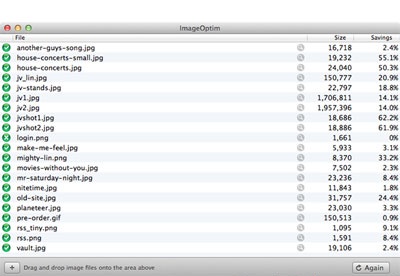
We then ran them through the Optimus WordPress image optimizer plugin to compress them.
IMAGEOPTIM FOR WORDPRESS FULL
We uploaded five different full resolution JPGs (most of them averaging between 1-5 MB). You can read our post on more of the differences between lossy and lossless compression. Usually, this is done by removing unnecessary metadata from JPEG and PNG files. Lossless compression refers to compression in which the image is reduced without any quality loss. The optimization of images - including thumbnails - is conducted automatically in the background and outside of the view of the user when you upload to the WordPress media library. It is developed and maintained by the team at Ke圜DN, a global content delivery, with a sole focus on performance. In our examples below we are using the Optimus image optimizer, as this allows us to take our image optimization even further with WebP and lossless image compression. But large reductions are very common, especially for those that have not yet optimized their images. Again, this all depends on your level of compression and the image file format you choose to go with. This means on that 1562 KB example above, that is almost 1 MB of savings that could be had. Typically users that take advantage of a good WordPress image optimizer can see savings of up to 70%, and sometimes even more. The solution is finding the best ways to optimize them.

Why? Because images have grown to larger sizes, especially with retina now in the mix, as well as websites today simply tend to be larger with a lot more content than they used to be. Over 6 years we have seen a slight growth of 4%. In December 2010, images made up 60% of an average webpage's weight. are all good web performance optimizations, but almost none of them will show you such drastic results. A CDN, a fast web host, lightweight plugins, etc. This means that image optimization should be at the top of your list when it comes to determining ways to speed up your website. ImagesĪccording to HTTP Archive, as of August 2016, images on a website make up for an average of 64% of a webpage's weight, with video coming in 2nd at 17%. That is why it is important to use a WordPress image optimizer plugin.

One of the biggest delays with WordPress sites all comes down to image optimization. There is a reason that over 26% of all websites on the internet choose WordPress, and that is because it is flexible, reliable, and easy to use. WordPress might not be the fastest platform you could use for your website out of the box, but with a little optimization that can easily be remedied.


 0 kommentar(er)
0 kommentar(er)
